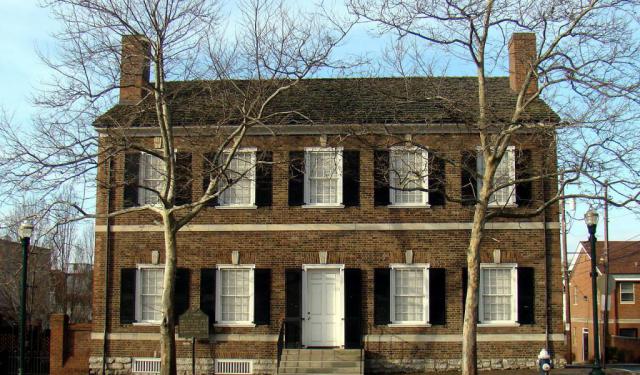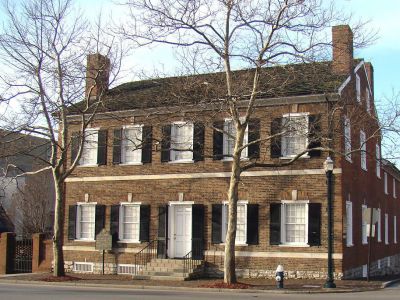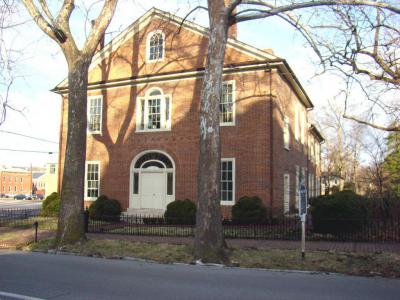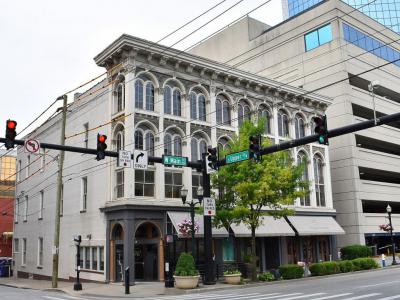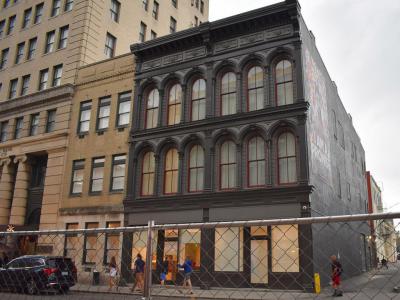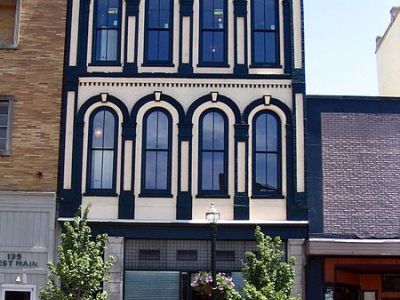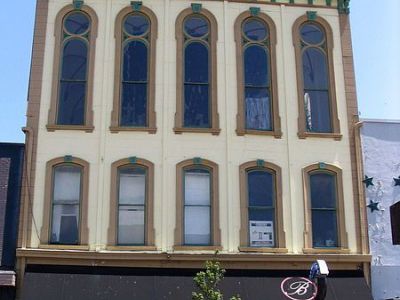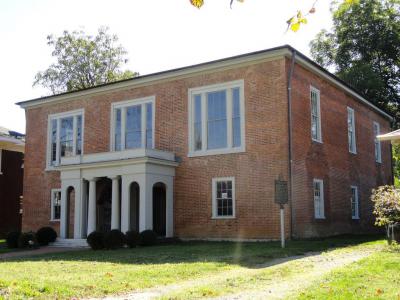Historical Buildings (Self Guided), Lexington
Historical buildings in Lexington, Kentucky, serve as time capsules, reflecting the architectural and cultural history of the region. A good number of these structures are listed in the National Register of Historic Places, each having its own story to tell. Let's explore a few notable structures that have made significant architectural contributions to the cityscape of Lexington.
The foremost of them is the Mary Todd Lincoln House, the childhood home of the former First Lady, wife of the 16th President of the United States, Abraham Lincoln.
The Hunt-Morgan House, otherwise known as Hopemont, showcases Federal style and was once home to John Wesley Hunt, a prominent early Kentucky settler.
The McAdams and Morford Building, much like the Higgins Block, represent examples of 19th-century commercial architecture, reflecting Lexington's economic growth and prosperity during that era.
The Randall Building, with its striking Italianate Victorian design, is an architectural gem from the late 19th century.
The Odd Fellows Temple holds a special place as a historic fraternal lodge, underscoring the social and community aspects of Lexington's past.
Lastly, the Pope Villa, an early 19th-century home, designed by Benjamin Henry Latrobe, showcases avant-garde architecture and reflects the influence of Thomas Jefferson's ideas.
Collectively, these centuries-old buildings are more than just bricks and mortar but a live representation of the unique history of Lexington. On this self-guided walk, we invite you to visit them, absorb their stories, and learn about the city's development, influential figures, and changing architectural styles.
The foremost of them is the Mary Todd Lincoln House, the childhood home of the former First Lady, wife of the 16th President of the United States, Abraham Lincoln.
The Hunt-Morgan House, otherwise known as Hopemont, showcases Federal style and was once home to John Wesley Hunt, a prominent early Kentucky settler.
The McAdams and Morford Building, much like the Higgins Block, represent examples of 19th-century commercial architecture, reflecting Lexington's economic growth and prosperity during that era.
The Randall Building, with its striking Italianate Victorian design, is an architectural gem from the late 19th century.
The Odd Fellows Temple holds a special place as a historic fraternal lodge, underscoring the social and community aspects of Lexington's past.
Lastly, the Pope Villa, an early 19th-century home, designed by Benjamin Henry Latrobe, showcases avant-garde architecture and reflects the influence of Thomas Jefferson's ideas.
Collectively, these centuries-old buildings are more than just bricks and mortar but a live representation of the unique history of Lexington. On this self-guided walk, we invite you to visit them, absorb their stories, and learn about the city's development, influential figures, and changing architectural styles.
How it works: Download the app "GPSmyCity: Walks in 1K+ Cities" from Apple App Store or Google Play Store to your mobile phone or tablet. The app turns your mobile device into a personal tour guide and its built-in GPS navigation functions guide you from one tour stop to next. The app works offline, so no data plan is needed when traveling abroad.
Historical Buildings Map
Guide Name: Historical Buildings
Guide Location: USA » Lexington (See other walking tours in Lexington)
Guide Type: Self-guided Walking Tour (Sightseeing)
# of Attractions: 7
Tour Duration: 1 Hour(s)
Travel Distance: 2.4 Km or 1.5 Miles
Author: emily
Sight(s) Featured in This Guide:
Guide Location: USA » Lexington (See other walking tours in Lexington)
Guide Type: Self-guided Walking Tour (Sightseeing)
# of Attractions: 7
Tour Duration: 1 Hour(s)
Travel Distance: 2.4 Km or 1.5 Miles
Author: emily
Sight(s) Featured in This Guide:
- Mary Todd Lincoln House
- Hunt-Morgan (Hopemont) House
- McAdams and Morford Building
- Higgins Block
- Randall Building
- Odd Fellows Temple
- Pope Villa
1) Mary Todd Lincoln House (must see)
The Mary Todd Lincoln House was the childhood home of Mary Ann Todd, born here in 1818 and later the wife of President Abraham Lincoln. Built between 1803 and 1806 in the Georgian/Federal style, the house originally served as an inn before being acquired by Mary’s father, Robert Smith Todd, in 1832. The Todds resided here until 1839, when Mary moved to Illinois, but Mary and President Lincoln returned in 1847 for a family visit.
Today, the fourteen-room brick structure is preserved as a museum and stands as the first historic site in America dedicated to a First Lady. Thanks to a major restoration spearheaded in the 1970s by the Kentucky Mansions Preservation Foundation under Beula C. Nunn, the home reopened to the public in 1977. Its carefully curated interiors house original Todd and Lincoln family furnishings, period portraits, and artifacts that vividly reflect early 19th-century life and Mary’s upbringing.
Visitors can explore the home via 30-minute self-guided tours or a one-hour guided experience (reservations recommended for the latter). The museum is partially wheelchair‑accessible, featuring a lift to the first floor and a photo album for glimpses of the upstairs areas. After the tour, guests can enjoy the shop, the charming Beula C. Nunn garden, and a self-guided walking tour of Lexington, including sites linked to Mary and Abraham’s time in the city.
More than just a house, this site explores the intersection of Northern and Southern identities before, during, and after the Civil War. Mary Lincoln grew up in a well‑to‑do, slaveholding family, yet her life was later shaped by abolitionist influence and personal tragedy. As you wander through the parlors, bedrooms, and collection of china and portraits, you’ll gain an intimate understanding of the woman who became a sophisticated and politically engaged First Lady-and who endured controversy, loss, and resilience amidst a divided nation.
Today, the fourteen-room brick structure is preserved as a museum and stands as the first historic site in America dedicated to a First Lady. Thanks to a major restoration spearheaded in the 1970s by the Kentucky Mansions Preservation Foundation under Beula C. Nunn, the home reopened to the public in 1977. Its carefully curated interiors house original Todd and Lincoln family furnishings, period portraits, and artifacts that vividly reflect early 19th-century life and Mary’s upbringing.
Visitors can explore the home via 30-minute self-guided tours or a one-hour guided experience (reservations recommended for the latter). The museum is partially wheelchair‑accessible, featuring a lift to the first floor and a photo album for glimpses of the upstairs areas. After the tour, guests can enjoy the shop, the charming Beula C. Nunn garden, and a self-guided walking tour of Lexington, including sites linked to Mary and Abraham’s time in the city.
More than just a house, this site explores the intersection of Northern and Southern identities before, during, and after the Civil War. Mary Lincoln grew up in a well‑to‑do, slaveholding family, yet her life was later shaped by abolitionist influence and personal tragedy. As you wander through the parlors, bedrooms, and collection of china and portraits, you’ll gain an intimate understanding of the woman who became a sophisticated and politically engaged First Lady-and who endured controversy, loss, and resilience amidst a divided nation.
2) Hunt-Morgan (Hopemont) House (must see)
The Hunt–Morgan House-also known as Hopemont-is a stunning example of Federal-period architecture nestled in the heart of Lexington’s charming Gratz Park Historic District. Built in 1814 by John Wesley Hunt, Kentucky’s first millionaire, the two-story brick mansion is notable for its elegant symmetry, Flemish-bond façade, arched fanlight doorway, and central Palladian window-all hallmarks of the refined architectural taste of the early 19th century. Its graceful proportions and meticulous craftsmanship continue to draw admiring glances from architecture lovers and casual visitors alike.
Beyond its visual appeal, Hopemont carries a rich tapestry of historical stories. The Hunt-Morgan family left a significant mark on American history-John Hunt Morgan, the famed Confederate cavalry leader known as the “Thunderbolt of the Confederacy,” was raised in the house, and Dr. Thomas Hunt Morgan-born here in 1866-became the first Kentuckian honored with a Nobel Prize in Physiology or Medicine. On the second floor, the Alexander T. Hunt Civil War Museum offers insights into this turbulent era via letters, uniforms, and artifacts that enrich the narrative of the house.
Saved from demolition in 1955, Hopemont is now lovingly preserved by the Blue Grass Trust for Historic Preservation. Tours take you through beautifully restored period rooms, including a grand cantilevered central staircase, a formal parlor, dining room, and a garden-facing office space-each space evoking life in early Lexington. The house also frequently hosts art exhibitions, lectures, and private events, lending it a vibrant, community‑centered spirit.
For tourists exploring historic Lexington, Hopemont is more than a stately relic-it’s a gateway into Kentucky’s past. Its prime location on Mill Street means nearby landmarks and walking paths await just steps away. Whether you’re drawn by architecture, local history, Civil War stories, or simply a quiet stroll through Gratz Park, the Hunt–Morgan House offers a beautifully layered experience that connects you to the early soul of “The Athens of the West.”
Beyond its visual appeal, Hopemont carries a rich tapestry of historical stories. The Hunt-Morgan family left a significant mark on American history-John Hunt Morgan, the famed Confederate cavalry leader known as the “Thunderbolt of the Confederacy,” was raised in the house, and Dr. Thomas Hunt Morgan-born here in 1866-became the first Kentuckian honored with a Nobel Prize in Physiology or Medicine. On the second floor, the Alexander T. Hunt Civil War Museum offers insights into this turbulent era via letters, uniforms, and artifacts that enrich the narrative of the house.
Saved from demolition in 1955, Hopemont is now lovingly preserved by the Blue Grass Trust for Historic Preservation. Tours take you through beautifully restored period rooms, including a grand cantilevered central staircase, a formal parlor, dining room, and a garden-facing office space-each space evoking life in early Lexington. The house also frequently hosts art exhibitions, lectures, and private events, lending it a vibrant, community‑centered spirit.
For tourists exploring historic Lexington, Hopemont is more than a stately relic-it’s a gateway into Kentucky’s past. Its prime location on Mill Street means nearby landmarks and walking paths await just steps away. Whether you’re drawn by architecture, local history, Civil War stories, or simply a quiet stroll through Gratz Park, the Hunt–Morgan House offers a beautifully layered experience that connects you to the early soul of “The Athens of the West.”
3) McAdams and Morford Building
The McAdams and Morford Building, a graceful three‑story landmark in the downtown, is a must-see for anyone touring the city. Erected in 1849 and originally known as Melodeon Hall, the building is celebrated for its cast‑iron Italianate façade, added in the late 1850s. The facade’s Corinthian pilasters, rounded arches, and ornate relief work offer a vivid example of Renaissance‑inspired design echoing Venetian palazzos.
Historically, Melodeon Hall on the building’s second floor was a cultural hub, seating roughly 300 patrons. Its stage hosted pivotal events in Kentucky history-most notably, Robert Jefferson Breckinridge’s 1861 speech that influenced Kentucky to remain in the Union during the Civil War. The ground floor served as McAdams & Morford Drugstore from 1898 until 1994, anchoring the local community for nearly a century.
In the early 20th century, the building also sheltered the Commercial College of Transylvania University, later known as the Wilbur R. Smith Business College, for over 35 years. Its architectural and cultural significance earned it a place on the National Register of Historic Places in 1973, cementing its status as a cherished historic treasure.
Today, the McAdams and Morford Building seamlessly merges its historic legacy with contemporary energy. A recent addition of dynamic LED lighting accentuates its graceful arches and columns after sunset, enhancing its presence in the nighttime streetscape. At street level, the building is now home to lively venues such as The Grove, Harvey’s Bar, and Hugo’s Ultralounge, contributing to its role as a social hub. For visitors, it offers an ideal vantage point, where architectural charm, local history, and the pulse of downtown Lexington come together.
Historically, Melodeon Hall on the building’s second floor was a cultural hub, seating roughly 300 patrons. Its stage hosted pivotal events in Kentucky history-most notably, Robert Jefferson Breckinridge’s 1861 speech that influenced Kentucky to remain in the Union during the Civil War. The ground floor served as McAdams & Morford Drugstore from 1898 until 1994, anchoring the local community for nearly a century.
In the early 20th century, the building also sheltered the Commercial College of Transylvania University, later known as the Wilbur R. Smith Business College, for over 35 years. Its architectural and cultural significance earned it a place on the National Register of Historic Places in 1973, cementing its status as a cherished historic treasure.
Today, the McAdams and Morford Building seamlessly merges its historic legacy with contemporary energy. A recent addition of dynamic LED lighting accentuates its graceful arches and columns after sunset, enhancing its presence in the nighttime streetscape. At street level, the building is now home to lively venues such as The Grove, Harvey’s Bar, and Hugo’s Ultralounge, contributing to its role as a social hub. For visitors, it offers an ideal vantage point, where architectural charm, local history, and the pulse of downtown Lexington come together.
4) Higgins Block
The Higgins Block stands as a captivating example of 19th-century Italianate commercial architecture. Built in 1872 and designed by renowned Lexington architect John McMurtry, this three-story brick building originally housed five storefronts along West Main Street, each framed by elegant cast-iron facades and grand two-over-two arched windows. Today, the structure you see retains two of those historic storefronts, a remnant of its former grandeur after part of the block was demolished in 1912 to make room for the Fayette National Bank Building.
As you approach the Higgins Block, admire the facade’s intricate details: Corinthian pilasters, bracketed cornice, dentil molding, and decorative relief panels-hallmarks of the Italianate style that flourished in post-Civil War America. These fine features earned it a place on the National Register of Historic Places in 1977, and it remains a contributing property within Lexington’s Downtown Commercial Historic District, which showcases a rich tapestry of architectural styles from the 19th and early 20th centuries.
Visitors today will find the Higgins Block a charming stop amid bustling shops, eateries, and cultural sites. Its lighter, stucco-clad side and modern storefront inserts speak to the building’s resilient evolution-once praised as “the handsomest of any building in Lexington”, yet adapted over time to keep pace with the city. Take a moment to imagine horse-drawn carriages rolling past these windows in the late 1800s, and enjoy the blend of historic ambiance and vibrant urban life that defines Lexington’s Main Street.
Whether you’re a history buff, an architecture aficionado, or just exploring downtown, the Higgins Block is a modest but meaningful piece of Lexington’s story-an enduring testament to the city’s economic growth, changing skylines, and deep appreciation for preserving the echoes of its past.
As you approach the Higgins Block, admire the facade’s intricate details: Corinthian pilasters, bracketed cornice, dentil molding, and decorative relief panels-hallmarks of the Italianate style that flourished in post-Civil War America. These fine features earned it a place on the National Register of Historic Places in 1977, and it remains a contributing property within Lexington’s Downtown Commercial Historic District, which showcases a rich tapestry of architectural styles from the 19th and early 20th centuries.
Visitors today will find the Higgins Block a charming stop amid bustling shops, eateries, and cultural sites. Its lighter, stucco-clad side and modern storefront inserts speak to the building’s resilient evolution-once praised as “the handsomest of any building in Lexington”, yet adapted over time to keep pace with the city. Take a moment to imagine horse-drawn carriages rolling past these windows in the late 1800s, and enjoy the blend of historic ambiance and vibrant urban life that defines Lexington’s Main Street.
Whether you’re a history buff, an architecture aficionado, or just exploring downtown, the Higgins Block is a modest but meaningful piece of Lexington’s story-an enduring testament to the city’s economic growth, changing skylines, and deep appreciation for preserving the echoes of its past.
5) Randall Building
The Randall Building, fondly known today as Bogaert’s Jewelry Store, is one of Lexington’s charming architectural treasures. Built in the latter half of the 19th century, this Italianate‑Victorian commercial structure flaunts the tall, narrow arched windows and ornate cornice typical of the era. Its elegant façade, with its stately proportions and decorative brickwork, transports visitors back to a time when Lexington's Main Street bustled with merchants and entrepreneurs.
In recognition of its architectural and historic significance, the Randall Building was added to the National Register of Historic Places in 1982. It stands amidst a cluster of equally notable neighbors-such as the Odd Fellows Temple and McAdams & Morford Building-forming part of the city’s Downtown Commercial Historic District. Together, these landmarks tell the narrative of Lexington's rebirth following fires in the 1870s and again in 1917, helping to preserve the city’s 19th‑century commercial heritage.
For tourists, the Randall Building is both a visual delight and a piece of living history. As you stroll down West Main Street, take time to admire the striking symmetry of its windows, the contrast between brick and trim, and the stories etched into its masonry. If you’re following one of Lexington’s self‑guided historical walking tours, this site is often featured as a highlight-and for good reason. While the interior has hosted various businesses over the decades, including jewelers, today it remains an external emblem of a bygone, but not forgotten, era. Don’t miss this delightful gem on your stroll-its graceful yet unassuming presence quietly enriches the story of Lexington.
In recognition of its architectural and historic significance, the Randall Building was added to the National Register of Historic Places in 1982. It stands amidst a cluster of equally notable neighbors-such as the Odd Fellows Temple and McAdams & Morford Building-forming part of the city’s Downtown Commercial Historic District. Together, these landmarks tell the narrative of Lexington's rebirth following fires in the 1870s and again in 1917, helping to preserve the city’s 19th‑century commercial heritage.
For tourists, the Randall Building is both a visual delight and a piece of living history. As you stroll down West Main Street, take time to admire the striking symmetry of its windows, the contrast between brick and trim, and the stories etched into its masonry. If you’re following one of Lexington’s self‑guided historical walking tours, this site is often featured as a highlight-and for good reason. While the interior has hosted various businesses over the decades, including jewelers, today it remains an external emblem of a bygone, but not forgotten, era. Don’t miss this delightful gem on your stroll-its graceful yet unassuming presence quietly enriches the story of Lexington.
6) Odd Fellows Temple
The Odd Fellows Temple is a striking vestige of 19th-century civic pride. Constructed in 1869–70 and designed by local architect Cincinnatus Shryock, the building showcases a blend of Italianate elegance with a Second Empire mansard roof. This distinctive design feature, combined with ornate arched windows and decorative detailing, marks it as a visual gem amid the city’s historic Main Street.
Originally built for the Independent Order of Odd Fellows (IOOF)-a global fraternal organization founded in Baltimore in 1819-the temple symbolized charitable ideals such as friendship, love, and truth. The IOOF was among the first fraternal groups in the U.S. to accept women in 1851, underlining its progressive mission to support widows, orphans, the sick, and the bereaved. The Lexington lodge’s temple featured not only meeting halls but also public-facing clock tower structures, including “Skullers Clock” installed in front of the building.
As Lexington's commercial heart evolved, the Odd Fellows Temple adapted. It later housed the Skullers Jewelry company, yet retained its characteristic mansard profile and facade. Recognizing its architectural and historical importance, it was added to the National Register of Historic Places in 1980 and remains a featured highlight on walking tours of Lexington's historic downtown.
For visitors, the Odd Fellows Temple offers more than just a photo op-it’s a story of community, architecture, and fraternal service. When you visit, take a moment to admire Shryock's craftsmanship, envision the lodge meetings and civic events that took place within, and reflect on how this modest yet elegant structure has witnessed generations of Lexington’s civic life.
Originally built for the Independent Order of Odd Fellows (IOOF)-a global fraternal organization founded in Baltimore in 1819-the temple symbolized charitable ideals such as friendship, love, and truth. The IOOF was among the first fraternal groups in the U.S. to accept women in 1851, underlining its progressive mission to support widows, orphans, the sick, and the bereaved. The Lexington lodge’s temple featured not only meeting halls but also public-facing clock tower structures, including “Skullers Clock” installed in front of the building.
As Lexington's commercial heart evolved, the Odd Fellows Temple adapted. It later housed the Skullers Jewelry company, yet retained its characteristic mansard profile and facade. Recognizing its architectural and historical importance, it was added to the National Register of Historic Places in 1980 and remains a featured highlight on walking tours of Lexington's historic downtown.
For visitors, the Odd Fellows Temple offers more than just a photo op-it’s a story of community, architecture, and fraternal service. When you visit, take a moment to admire Shryock's craftsmanship, envision the lodge meetings and civic events that took place within, and reflect on how this modest yet elegant structure has witnessed generations of Lexington’s civic life.
7) Pope Villa
The Pope Villa is a hidden treasure with deep architectural and historical significance. Designed in 1811–12 by Benjamin Henry Latrobe-often referred to as America’s first professional architect-for Senator John Pope and his wife Eliza, this elegant brick villa is one of only three surviving Latrobe residences in the entire United States. Though modest in its outward appearance, its compact square form conceals a sophisticated interior featuring a domed rotunda and a suite of graceful apsidal rooms - an early expression of neoclassical elegance tied to the ideals of the young republic.
Visiting the Pope Villa today offers a glimpse into the bold aspirations of early American architecture. Although Benjamin Henry Latrobe never traveled to Kentucky, he relied on the Popes-particularly the refined and well-traveled Eliza-to help refine his design. The result was a home that blended classical elements with a uniquely picturesque interior. While a fire in 1987 and later modifications concealed much of the villa’s original character, a careful restoration in the 2010s has since removed those layers, revealing Latrobe’s vision in a form close to its original state.
Visitors should note that the villa can only be toured by appointment, managed by the Blue Grass Trust for Historic Preservation. On-site, you’ll be guided through the villa’s unusual square layout, historical tidbits about the Popes and their genteel Washington connections, and the subtle ways Latrobe’s design alludes to the halls of Congress-particularly the circular skylight and rotunda that echo the Capitol’s architecture.
As both a quiet residential landmark and a testament to early 19th‑century cultural ambitions, the Pope Villa offers history lovers and architecture aficionados a rare glimpse into Lexington’s past. Whether arriving to admire its faded grandeur or to appreciate its carefully restored interior nuances, visitors will discover why this unassuming building holds a pivotal place in Kentucky’s built landscape-and why it’s worth carving into any cultural itinerary.
Visiting the Pope Villa today offers a glimpse into the bold aspirations of early American architecture. Although Benjamin Henry Latrobe never traveled to Kentucky, he relied on the Popes-particularly the refined and well-traveled Eliza-to help refine his design. The result was a home that blended classical elements with a uniquely picturesque interior. While a fire in 1987 and later modifications concealed much of the villa’s original character, a careful restoration in the 2010s has since removed those layers, revealing Latrobe’s vision in a form close to its original state.
Visitors should note that the villa can only be toured by appointment, managed by the Blue Grass Trust for Historic Preservation. On-site, you’ll be guided through the villa’s unusual square layout, historical tidbits about the Popes and their genteel Washington connections, and the subtle ways Latrobe’s design alludes to the halls of Congress-particularly the circular skylight and rotunda that echo the Capitol’s architecture.
As both a quiet residential landmark and a testament to early 19th‑century cultural ambitions, the Pope Villa offers history lovers and architecture aficionados a rare glimpse into Lexington’s past. Whether arriving to admire its faded grandeur or to appreciate its carefully restored interior nuances, visitors will discover why this unassuming building holds a pivotal place in Kentucky’s built landscape-and why it’s worth carving into any cultural itinerary.
Walking Tours in Lexington, Kentucky
Create Your Own Walk in Lexington
Creating your own self-guided walk in Lexington is easy and fun. Choose the city attractions that you want to see and a walk route map will be created just for you. You can even set your hotel as the start point of the walk.
Lexington Introduction Walking Tour
Lexington is Kentucky's second-largest city and the Fayette County seat. The city is most famous for the Thoroughbred racing industry but has so much to offer besides attractions related to racing. This city dates back to 1782 when Kentucky was still part of the Commonwealth of Virginia and was settled by frontiersmen under the leadership of William McConnell.
During the 19th century, the... view more
Tour Duration: 2 Hour(s)
Travel Distance: 4.3 Km or 2.7 Miles
During the 19th century, the... view more
Tour Duration: 2 Hour(s)
Travel Distance: 4.3 Km or 2.7 Miles
The Most Popular Cities
/ view all
